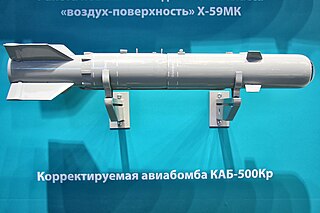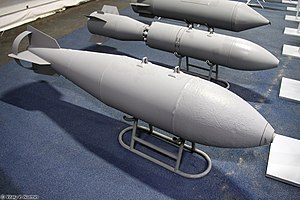
The KAB-500Kr is an electro-optical TV-guided fire and forget bomb developed by the Soviet Air Force in the 1980s. It remains in service with the CIS and various export customers.

The Mikoyan MiG-27 was a variable-sweep ground-attack aircraft, originally built by the Mikoyan-Gurevich design bureau in the Soviet Union and later licence-produced in India by Hindustan Aeronautics as the Bahadur ("Valiant"). It is based on the Mikoyan-Gurevich MiG-23 fighter aircraft, but optimised for air-to-ground attack. Unlike the MiG-23, the MiG-27 did not have widespread use outside Russia, as most countries opted for the Mikoyan-Gurevich MiG-23BN and Sukhoi Su-22 instead. As of late 2023, all Russian, Indian, Sri Lankan, Ukrainian, and Kazakh MiG-27s have been retired, bringing the type's service to an end.
The Kh-22 "Storm" is a large, long-range anti-ship cruise missile developed by MKB Raduga in the Soviet Union. It was designed for use against aircraft carriers and carrier battle groups, with either a conventional or nuclear warhead. Kh-32 is an updated conventional variant of the Kh-22 and was accepted to service in 2016; it features an improved rocket motor and a new seeker head.

A general-purpose bomb is an air-dropped bomb intended as a compromise between blast damage, penetration, and fragmentation in explosive effect. They are designed to be effective against enemy troops, vehicles, and buildings.

The S-8 is a rocket weapon developed by the Soviet Air Force for use by military aircraft. It remains in service with the Russian Aerospace Forces and various export customers.

The Petlyakov Pe-8 was a Soviet heavy bomber designed before World War II, and the only four-engine bomber the USSR built during the war. Produced in limited numbers, it was used to bomb Berlin in August 1941. It was also used for so-called "morale raids" designed to raise the spirit of the Soviet people by exposing Axis vulnerabilities. Its primary mission, however, was to attack German airfields, rail yards and other rear-area facilities at night, although one was used to fly the People's Commissar of Foreign Affairs Vyacheslav Molotov from Moscow to the United States in 1942.

The Kh-59 Ovod is a Russian cruise missile with a two-stage solid-fuel propulsion system and 200 km range. The Kh-59M Ovod-M is a variant with a bigger warhead and turbojet engine. It is primarily a land-attack missile; the Kh-59MK variant targets ships.

Engels-2 is a strategic bomber military airbase in Russia located 14 kilometres (8.7 mi) east of Saratov. Engels is a major bomber operations base, and is Russia's sole operating location for the Tupolev Tu-160 strategic bomber. The base has a 3,500-metre (11,500 ft) runway and about 10 large revetments. It is named after the nearby city of Engels, which is named after the Communist philosopher, Friedrich Engels.

NPO Bazalt is a weapons manufacturing company in Russia that took over the production of weapons such as the RPG-7 after the collapse of the Soviet Union. NPO Bazalt manufactures the RPG-7V2 and the RPG-29. AO NPO Bazalt is included in the state corporation Rostec.

The KS-19 100mm anti-aircraft gun is a Soviet anti-aircraft gun that also features efficient capabilities against ground targets.

A precision-guided munition (PGM), also called a smart weapon, smart munition, or smart bomb, is a guided munition intended to hit a specific target, to minimize collateral damage and increase lethality against intended targets. During the Persian Gulf War guided munitions accounted for only 9% of weapons fired, but accounted for 75% of all successful hits. Despite guided weapons generally being used on more difficult targets, they were still 35 times more likely to destroy their targets per weapon dropped.
This is a glossary of acronyms and initials used for aircraft weapons in the Russian Federation and formerly the USSR. The Latin-alphabet names are phonetic representations of the Cyrillic originals, and variations are inevitable.

The OFAB-100-120 is a small bomb that can be carried on Sukhoi Su-17, Sukhoi Su-25, MiG-29, Su-27, Sukhoi Su-30 and various other aircraft.
The FAB 5000NG was a 5,000 kilogram large air-dropped, thin cased, high explosive demolition bomb used by the Soviet Air Forces during World War II. The device was the most powerful aerial bomb in the wartime Soviet inventory.
RBK-500 is a Russian 500 kg cluster bomb. It carries 15 "Motiv-3" SPBE-D antitank submunitions developed by NPO Bazalt with dual-mode infrared homing system. It entered service with the Soviet Air Force in 1987.
KAB-1500 is a Russian precision guided weapon which comes in three versions: KAB-1500L, KAB-1500S-E and TV-guided KAB-1500KR.

The FAB-9000 (Russian:ФАБ-9000) is a Soviet-made aerial bomb. FAB stands for Fugasnaya Aviatsionnaya Bomba and 9000 stands for the weight of the bomb in kilograms. It is one of the heaviest bombs of the Soviet Air Forces and the Russian Aerospace Forces.

The FAB-250 is a Soviet-designed 250-kilogram (550 lb) general purpose air-dropped bomb with a high-explosive warhead, primarily used by the Russian Air Force, former Soviet republics and customer countries. It is very widespread throughout the Third World and used in many conflicts in Asia and Africa among others. The original M-46 model was rolled out in 1946, followed by the M-54 model 1954 with reinforced structure, both models shaped for internal carriage by heavy bombers, a low-drag M-62 version in 1962 was intended for fighter bomber external hardpoint carriage. The bomb is unguided, features a single nose fuse, and is compatible with most models of Soviet aircraft. The FAB-250 was extensively employed over Afghanistan by Soviet and allied Afghan forces during the 1980s. The FAB-250 has been used most recently over Syria by both Russian and Syrian warplanes. Ethiopia used it during the Tigray War.

UMPK is a guidance kit first developed by the Russian Bazalt Design Bureau for converting unguided Soviet bombs into precision-guided munitions. This kit is an aerial bomb glide range extension kit, similar to the American Joint Direct Attack Munition (JDAM). The guidance system and gliding function of the UMPK kit can provide ordinary aerial bombs with longer-range and more accurate strike capabilities. They have been widely used by the Russian Air Force during the Russian invasion of Ukraine.
Soviet Union and Russian Federation developed a range of aerial bombs for use on its aircraft.
















